Seven million five hundred twenty thousand people. This is the Twitter user count*1 published by NetRatings Japan, Inc. in March 2010. As the user count rises, so do businesses utilizing Twitter. Unfortunately, though, not much is talked about in regard to analyzing Twitter activities.
How are my company’s or competitors’ products are portrayed on Twitter?
What is the inflow count to my website via Twitter or the conversion count thereof?
How do I evaluate my account?
Obtaining information from Twitter and analyzing it free of charge is the content of this article.
Twitter is a treasure chest of information often overflowing with frank user discussions. Even if your company does not have an account, a vast range of opinions about your services or industry are posted on Twitter. There is no reason why we cannot take advantage of this for marketing.
This article is going to be long, so please read when you have some spare time.
Table of Contents
- How to Obtain Information from Twitter
1.1 Tweet information
1.2 Account Information
1.3 Access Analysis Information
- How to Analyze Information
2.1 Analyze Your Corporate Account
2.2 Analyze Your Corporate Branding
2.3 Analyze Your Corporate Campaigns
2.4 Analyze Your Competitors
2.5 Analyze Related Words
2.6 Analyze Tweeters
- Twitter Analysis: Issues and Its Future
1. How to Obtain Information from Twitter
There are mainly three types of information you can obtain from Twitter.
1: Information about posted tweets.
2: Information about Twitter accounts.
3: Information about the inflow via Twitter, or its conversion.
Let’s look at these three types more specifically.
1.1 Tweet Information
I recommend using the Twitter-specific search engines to find required tweets. I will introduce to you some useful search engines*2.
1.1.1 Official Twitter search engine
URL: http://search.twitter.com/
Characteristics: You can perform a search not only by keywords, but also by various parameters including language (possible to retrieve only the tweets in Japanese), period, Twitter ID, hashtag, or Boolean OR/AND operator, to name a few. You can also receive the search result via RSS feed, so you can see new tweets as soon as they are posted.
I searched for the term “アクセス解析 (access analysis).”
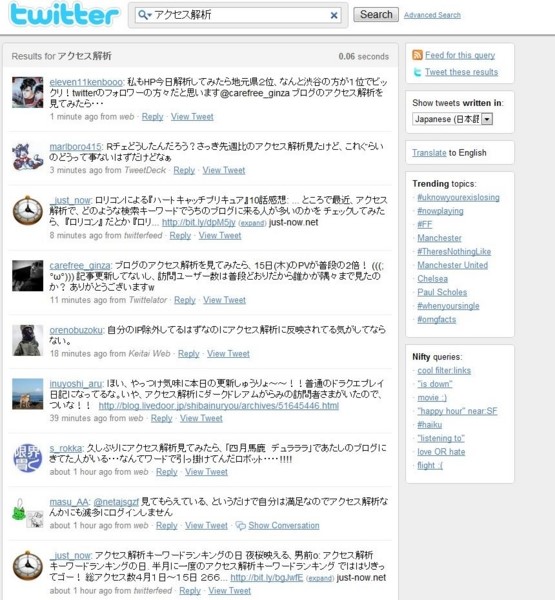
1.1.2 me*you
URL: http://meyou.jp/
Characteristics: this engine enables you to narrow down the target of the search to only profiles. You can follow in bulk those who have matched the search terms, so this engine comes in handy when you are to gain contacts with those who have a high affinity to specific terms. You can also add regions or periods to your search.
The search result using “映画 (movies)” AND “東京から15 km以内にいるユーザー (users located within 15 km from Tokyo.”
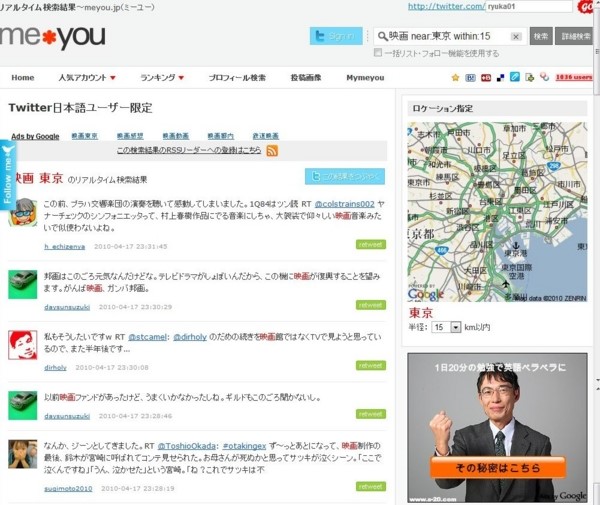
1.1.3 Twimono.com
URL: http://twimono.com/
Characteristics: A search engine specialized in products. You can see detailed information related to products; for example, you can see popular products by genre at a glance or look at the mention counts of a specific product in a trend line. If a product is not registered on this platform, you can add it if it is listed on Amazon.
Information about “じゃがりこ (Jagarico potato stick snack).”
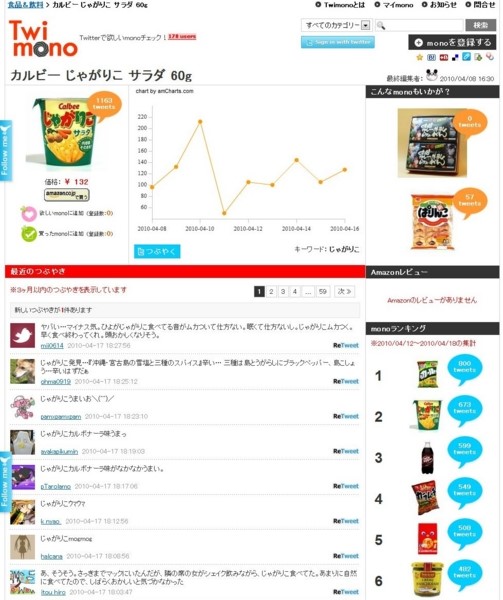
1.1.4 Topsy
URL: http://topsy.com/
Characteristics: This is also a search engine with two convenient functions. First, in the search result screen, the total numbers of tweets with the keyword are displayed by month, by week, by day, and by the hour. Second, even more conveniently, you can search a URL if you input in the “Site: <enter here>” bar. Shortened URLs can also be searched.
I searched using my blog URL.
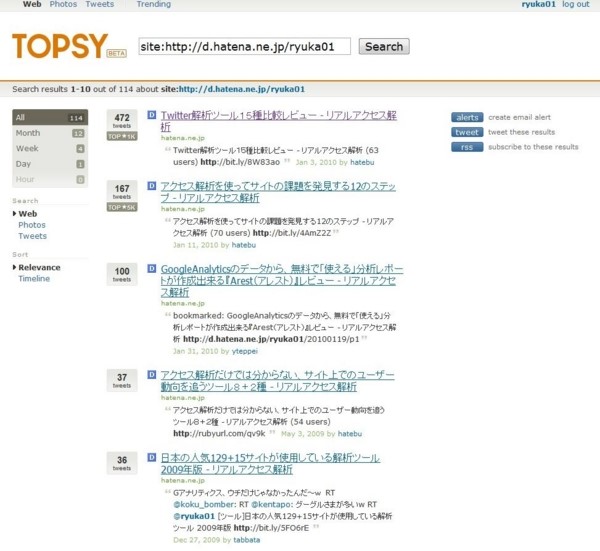
If you click the tweet count, you can see what types of comments accompany the retweets, and you can also narrow down the retweets to only those by influencers.
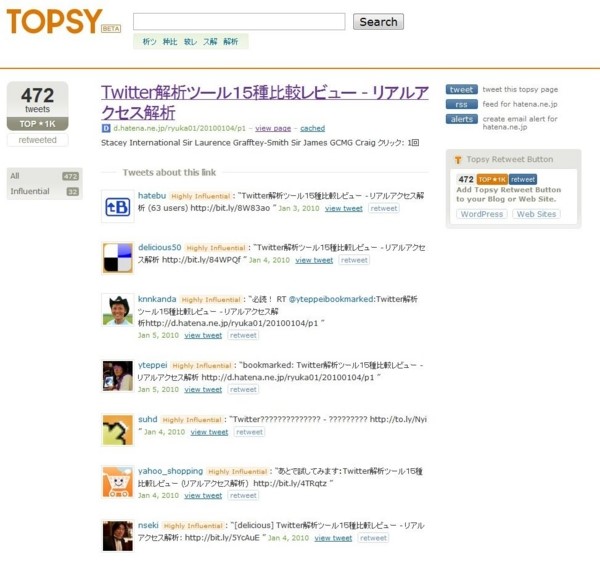
1.2 Account Information
There are various tools out there used to obtain information related to your corporate Twitter account. These analysis tools are introduced in the “15 Twitter Analysis Tools Comparative Review” article on this blog. Among the 15, I picked a few tools that are suitable for corporations.
1.2.1 TweetStats
Characteristics: You can see detailed information about the tweet count. When the tweets are posted? With what Twitter IDs does my corporate account frequently communicate? These are some examples of what can be gleaned from Twitter. You can also see the word cloud of your tweets so that you can see the utilized keywords in one glance*3.
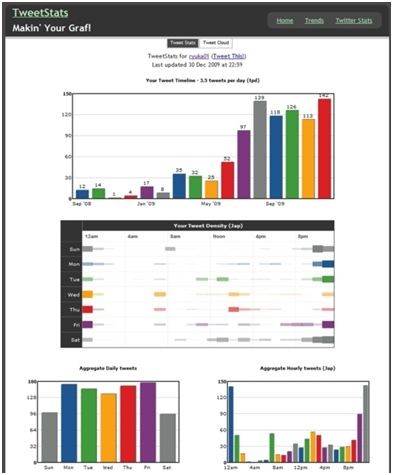
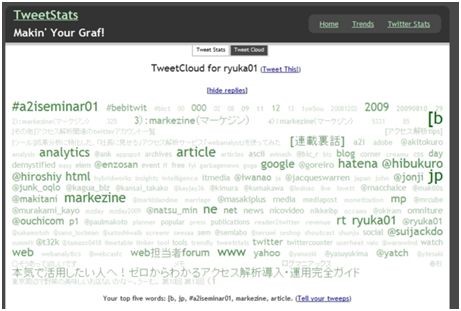
1.2.2 Tweeteffect
URL: http://www.tweeteffect.com/
Characteristics: The number of followers for the last 200 tweets is displayed. You can tell what comment prompted the people to follow you and more. It is interesting to see what comments increased or decreased a large number of followers.
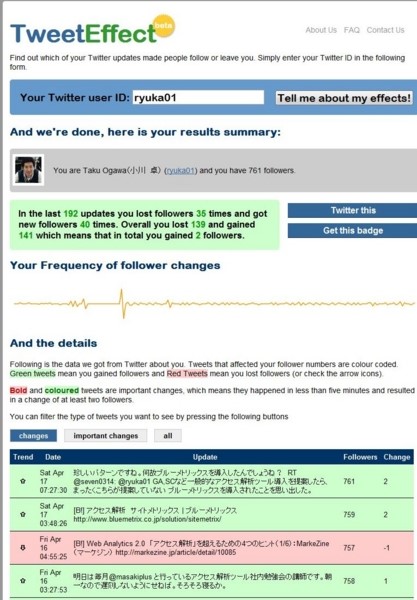
1.2.3 Twitalyzer
Characteristics: This platform integrates the functions that an access analysis tool is usually equipped with, such as enabling linkage with Google Analytics, distribution comparisons with the accounts of others, in-house indices with their detailed definitions, goal setting, and memo function. It is on the weaker side compared to other tools when it comes to the tweet counts or the follower-related functions; nonetheless, it is a comprehensive tool. It is a pity that you cannot perform search or filtering in Japanese.
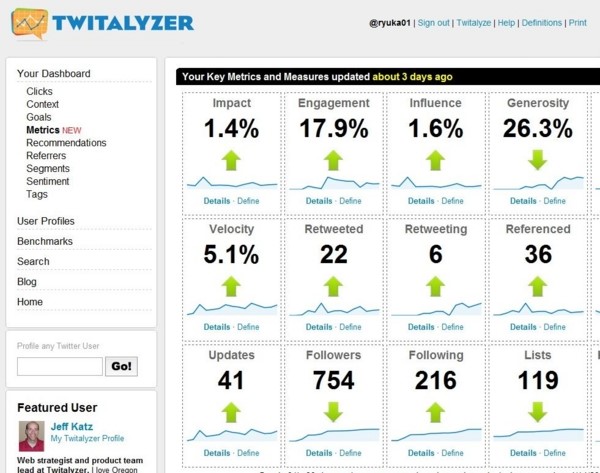
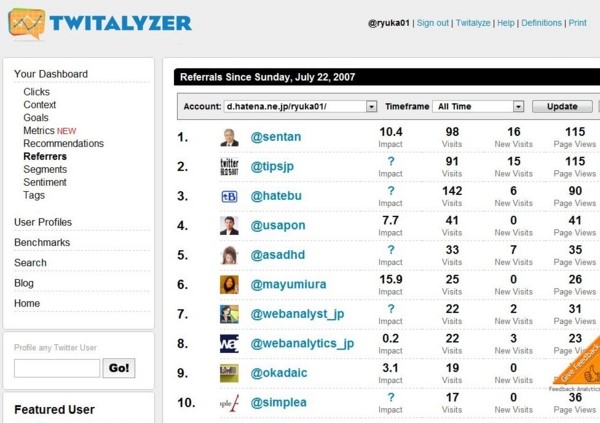
1.2.4 Twimpact
URL: http://twimpact.jp/
Characteristics: You can see the ranking of a retweeted tweet when you enter a Twitter ID into the search bar. You can also see who retweeted and how the tweet spread on a radar chart.
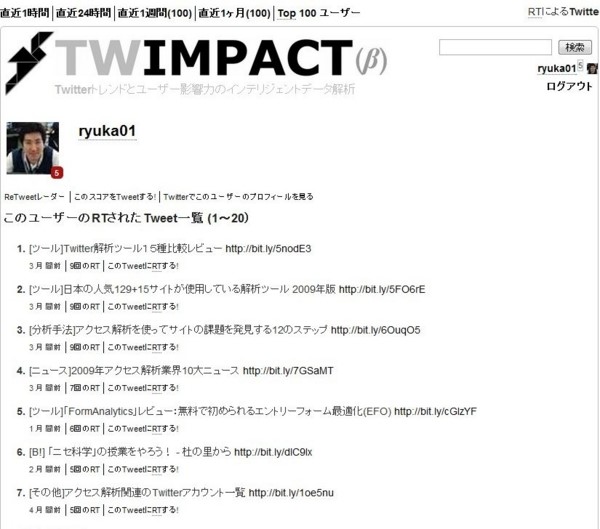
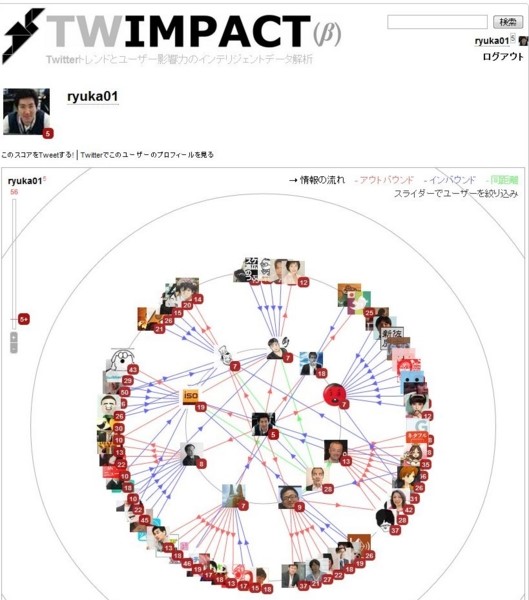
Please see “15 Twitter Analysis Tools Comparative Review” to read about the tools other than the above or to see the comparative table for the 15 tools.
1.3 Access Analysis Information
I picked up the characteristics of Twitter that have an impact on access analysis when you measure the inflow from Twitter as well as the conversion of the inflow.
- Characteristic 1: Most of the URLs used are shortened URLs.
- Characteristic 2: A tweet will spread by being retweet
- Characteristic 3: The access to Twitter is possible via various tools.
If I plug these three characteristics into the access analysis terms,
- Characteristic 1: When shortened URLs are the referrers, the referrers will appear as the URL of the URL shortening service, not twitter.com.
- Characteristic 2: The links are pasted in numerous places, so the link URLs cannot be controlled.
- Characteristic 3: In some cases, referrers are not obtainable.
Compared with the links from websites or search engines, it is the difficulty in obtaining accurate figures that is problematic with the Twitter analysis.
Then, how can you do the measurements? In principle, the measurements are taken by generating a URL with a campaign parameter shortened by a URL shortening service and tweeting that URL, instead of utilizing the less accurate referrers*4. By appending a campaign parameter to a URL, an access analysis tool can measure the inflow counts and conversion counts by the parameter.
Example: http://d.hatena.ne.jp/ryuka01/ ⇒ http://d.hatena.ne.jp/ryuka01?cd=twitter01
If you use Google Analytics, you can generate such a URL utilized in campaign measurement by using the Campaign URL Builder tool.
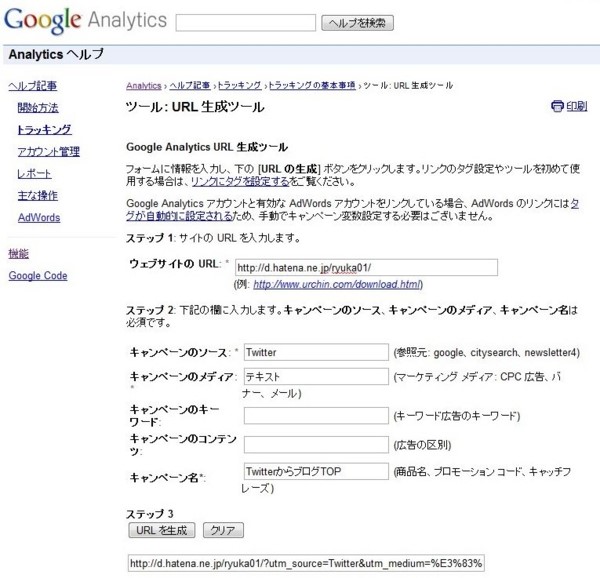
The generated URL is fiendishly long:
“http://d.hatena.ne.jp/ryuka01/?utm_source=twitter&utm_medium=%E3%83%86%E3%82%AD%E3%82%B9%E3%83%88&utm_campaign=twitter%E3%81%8B%E3%82%89%E3%83%96%E3%83%AD%E3%82%B0TOP%E3%81%B8%E3%81%AE%E6%B5%81%E5%85%A5.” There is no problem if a URL is long when used on websites, but two disadvantages arise when used on Twitter.
1: Too long (The length limit on Twitter per tweet is 140 characters.)
2: Those who know can tell a campaign code is appended.
That is when a URL shortening service comes to the rescue.
I recommend a URL shortening service Bit.ly, being popularly used by Twitter because it even comes with analytic functions. That lengthy URL shown above is shortened into http://bit.ly/9AGHLO. However, it is not always that you can capture all inflow if you have a campaign code-appended URL. That is because not all links can be made to a campaign code-added URL. Please look at the following table.
| Type of URL | Using for Your Account | Using for Others’ Accounts | Inflow Analysis Method | Conversion Analysis Method |
| Self-issued Shortened URL (with a campaign code) | Identify by the campaign code | Identify by the campaign code | Access analysis tool or URL shortening service | Access analysis tool |
| Shortened URL Issued by Others (without a campaign code) | Do not use | URL shortening service | URL shortening service | Analysis impossible |
| Regular URL Issued by Others (without a campaign code) | Do not use | Identification impossible | Identification impossible | Identification impossible |
The types of issued URLs are in the left-most column, and the identification methods for your and others’ accounts are in the next two columns. The tools that can be used to capture the inflow and conversion are in the right-most two columns.
The “Self-issued Shortened URL (with a campaign code)” in the first line is the case introduced so far. If you use Bit.ly, it is possible to find out the click count by date, and what types of comment went along with mentions if you only look at the inflow. You need to use the data from an access analysis tool to capture not only the inflow by campaign code but also the conversions.
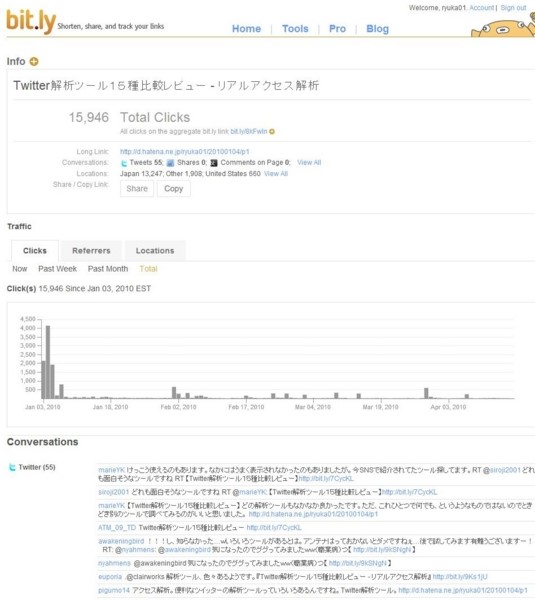
Let’s look at the “Shortened URL Issued by Others (without a campaign code)” in the second line. Because it is a shortened URL issued by others, in principle, it is not used by your account*5. Having said that, how do you measure the shortened URLs generated by others? If the URLs are generated by a URL shortening service that provides access analysis functions, view the information provided by the service. In the case of Bit.ly, you can see the analysis result by placing a + sign at the end of a URL.
Example: http://bit.ly/9AGHLO+
Other URL shortening services, such as Cli.gs, have access analysis functions. You cannot measure the inflow from a shortened URL generated by a service without access analysis functions.
The last line “Regular URL Issued by Others (without a campaign code)” is also not likely to be used by your account, but there are many instances in which others use that URL. In this case, as well, you cannot measure the inflow from the URL because no campaign code or shortened URL is used.
Unfortunately, as such, you cannot measure all inflow from Twitter. It is better to use Twitter, considering the inflow counts by URL in a relative term instead of chasing after the real numbers, for example, by comparing two campaigns as “this campaign was more popular than the other one.” There is a way to count the numbers of inflow from twitter.com or the domains of the major URL shortening services by referrer, but almost all clicks via the Twitter client cannot be captured, so the result is incomplete because of the incompleteness of the data.
2. How to Analyze Information
I have introduced data gathering methods thus far. From this point forward, I will show you what data are required for what types of analysis in six different ways.
2.1 Analyze Your Corporate Account
This is the first analysis you perform if you have your corporate account. You can gather these data by using various tools mentioned above. Important data are follower counts, retweet counts, the time of the day and the days of the week of tweets, and inflow to the website and conversion. You need to look at these indices from the following three aspects.
1: The Contents of Tweets
There are many types of contents such as advertisement/campaign, advice, helpful information, greetings, or thanks. Study the effects of tweets by tweet content type.
2: Actions on Twitter
Regardless of the contents, actions such as tweets without URLs, tweets with URLs, retweets of someone else’s tweets, you were retweeted, you tweeted to someone @xxxx, or you were tweeted @xxxx by someone are included.
3: Actions External to Twitter
The actions include publishing a press release, posting a report article on a website, television exposure, a marketing campaign, and a renovated website.
Analyze the changes in indices brought about by each aspect. Some examples are that the follower count increased after tweeting a piece of advice, or a notice of a press release is not effective in increasing followers, but the retweet count sometimes jumps. Record and utilize both actions that bring in good and bad results.
2.2 Analyze Your Corporate Branding
Let’s search for branding words such as company names or product names by using the search engines shown in 1.1.
The very first thing to look for in the search result is your corporate reputation. What opinions or impressions of the products and services do people have? Record tweet types such as positive/negative, opinions or wishes, or references as well as those tweets that left an impression on you. Analyzing the search results using a branding word and a second word is extremely effective. The words used with your corporate products and services vividly illustrate the images users have of them. Collect these associative words.
For example, some possible associative words for a piece of confectionery can be “good/bad taste,” “strong/plain flavor,” “high/low price,” “fashionable packaging,” “difficult to obtain” or “ate one at some occasion.” Research what kind of adjectives or verbs are used along with your corporate products.
It is essential for a branding analysis to check Twitter regularly because the Twitter users’ tastes/interests change quickly. Negative opinions spread especially rapidly. There are three main reasons for this phenomenon.
1: Twitter has a function called “retweet,” so tweets by others can be easily spread.
2: Because of the retweet function, the number of readers who read the retweeted tweets increase effortlessly.
3: Twitter has a low psychological or physical entrance barrier in posting messages compared with blogs or some other media. It is much easier to jot a message within mere 140 characters and click on the Tweet button than writing an article and posting it on a blog.
Just to give you an example, say a client received unreasonable treatment from telephone support staff of your company.
If Twitter did not exist, this fact would only be known to the client and his surrounding friends; even if he posts an article on his blog, there would be a time lag, and the fact would only be known to those who visit the blog themselves to read it. Let’s see how it would be in the case on Twitter.
Suppose the client is followed by 300 people. Upon tweeting, the tweet would reach the first 300. If five out of the 300 retweeted and the five had 200 followers each (on average), then, 300 people + 200 people * 5 = 1,300 people. Therefore, 1,300 people would have an impression of your company. If this process is repeated, you can understand how the client’s experience could be spread all around over in an instant.
One of the characteristics of Twitter is that past tweets are easily buried. Few Twitter users search past tweets, and a tweet‘s influence diminishes to none once a storm has past. However, unless you immediately take action to extinguish the fire, a client’s tweet might be posted on a blog that ranks high in search results by someone who has seen it.
If this happens, a negative impression could survive semi-permanently on the Internet. The important thing is to identify the information about your corporate products and services and correctly handle the situations as necessary. The quicker you handle this, the less damage there is. There is an opportunity to widely spread positive information about your company as well.
Let’s look at an example of analysis. The following are tweets about a product called “SimCity 4 Deluxe.” These are searched by using Twimono.
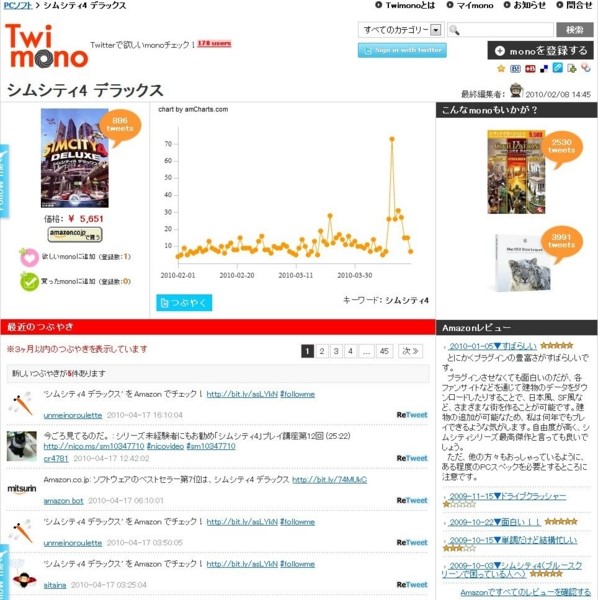
As you see, the number of tweets sharply increased on 4/12/2010. As I read through the tweets, I found that this day was the day the 12th installment video on how to play SimCity was uploaded to the “Nico Nico Douga” video website. This is a popular video series I also watch, and it was the first time they posted in several months, so those who were earnestly waiting for this video installment tweeted about it.
Some tweets posted on 4/12/2010.
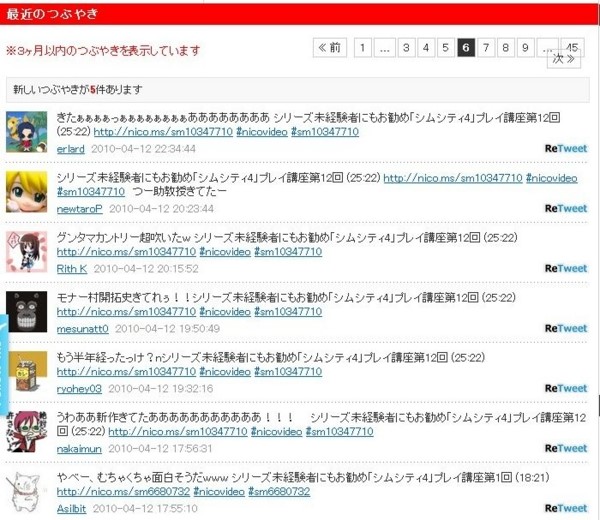
It was not until I analyzed the Twitter data that I finally found this fact because mentions were almost nil on blogs.
2.3 Analyze Your Corporate Campaigns
You may sometimes use Twitter as a medium for a campaign notice. If you already analyze your corporate website by using an access analysis tool, consider Twitter (though being unable to obtain accurate figures) as one of the inflow sources and look at the customer attraction effects of the campaign in the inflow count, conversion count, or the conversion rate (CVR).
However, there is more information you can obtain from Twitter itself. More specifically, the information includes the follower counts at the start and end of a campaign, the tweet count, how the notice is spread, or the numbers of positive/negative opinions. Be sure to keep records of qualitative data like these as well as quantitative data. You might want to create a template for keeping records. If you keep the records, you can see what kinds of campaigns have a large impact on the group that uses Twitter.
I will show you an example. Recruit Co., Ltd. created a website looking back at events from the past 50 years in celebrating its 50th anniversary. The opinions tweeted were:
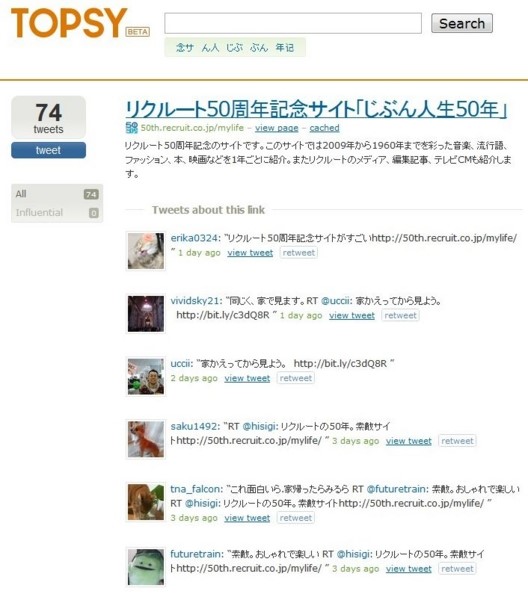
- This is interesting. I will look at it when I get home.
- Nice! It is fashionable and fun.
- The extent of elaboration Recruit poured into this website is quite impressive. I cannot help following the prices of a bowl of ramen noodles over the years. I can hear sounds.
- It is grandeur, and the amount of information is staggering. Recruit might be mistaken where to pour their effort, though.
- I got inspired by the website and came up with an interesting idea!!! Thanks!!!
- This website is incredible.
Relatively many opinions are in favor*6.
2.4 Analyze Your Competitors
After analyzing your company, you want to analyze your competitors. There is a variety of information you can get, such as how your competitors’ services, campaigns, or press releases are received by the masses, or if your company already has created or needs to create solutions for the unsatisfied needs of the masses.
How to obtain data on competitors is fundamentally the same as the methods in the branding analysis. Regularly search the tweets with your competitors’ company names or service names.
The essence is to learn from the users’ voices of your competitors’ services. Keep a record of your competitors’ successes and failures and reflect them in your company’s public relations. Let the planning and development teams know if you find superior points on the competitors’ website or services. It is important to let the teams directly listen to users’ voices. If you need people to act within your company, users’ frank opinions you see on Twitter are most influential.
Suppose your competitor PC manufacturer launched a new notebook PC. Make sure to perform a traversal analysis by obtaining a table of specs or looking at the design of the new model on the competitor’s website, check out the opinions about the media articles on Hatena Bookmark, or search the product name on Twitter and read the reactions of the people.
It has been difficult to find out the users’ voices of competitors. However, with Twitter, you may find tweets about the competitor’s new product presentation or even those of the staff of the competitors. Select good and bad points from the competitor analysis and apply them to your company’s practices.
2.5 Analyze Related Words
It is vital to know your industry-related words. This is strikingly effective when tweets about your company’s brands, products, and services are scarce.
If your company offers services related to condominiums, words such as “condominiums,” “rentals,” “newly constructed,” and “single homes” are the relevant words. If you use an access analysis tool, use top keywords that bring traffic, rather than brand words, and search for them on the Twitter search engine.
The search result for the word “保険 (insurance).”
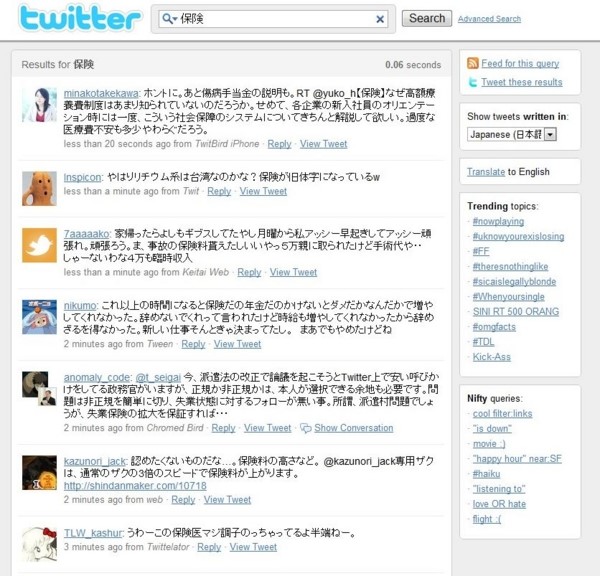
These words are convenient when you wish to attract visitors to your corporate website, products, and services. You can showcase your condominiums on your corporate Twitter if you see a tweet like “I am looking for a newly built condominium.”
Also, these words can help determine their trends. If your company is in the condominium industry, you can see the trends in comments, like “wondering if I should buy because the economy is bad,” or “interested in a property in the x area.” You might say that if one does not know the overall trend, he or she might simply be influenced by someone’s opinion. For that reason, utilize the results of research and questionnaires as well, not solely depending on the results of Twitter.
2.6 Analyze Tweeters
I focus on tweeters for the last analysis. List up those tweeters aggressively voicing their opinions on your corporate products and services. Recognize the fans and anti-fans of your company and attempt to contact especially those who command significant influence.
Ford, surprisingly, once launched a campaign where it gave away its new product, a car, that is, to 20 influencers on Twitter and had them regularly tweet their opinions. Many campaigns like these that involve tweeters are in place.
Not only listing up those tweeters but also put a qualitative analysis on them as to what kind of people they are. By reading profiles of the tweeters and their blogs introduced on Twitter, you can make sense out of the people who are interested in your company as to what lines of business or which generations they are in, whether male or female, or what hobbies they have. Make sure to use this analysis for your corporate marketing.
3. Twitter Analysis: Issues and Its Future
You need exceedingly long hours to do all data gathering and analyses introduced here. Pick a few and try them out first.
The top issue of the Twitter analysis is in its labor intensity. Various tools exist but are incomplete and non-compatible, and you need to skim through the tweets one by one. Besides the data gathering and analysis, there is also the implementational part of how to publicize and make the findings from analysis well known within your company, and how and in what context to apply them in public relations to attract customers. I am looking forward to seeing access analysis tools for the Twitter platform.
The access analysis tool “SiteCatalyst” by Adobe Systems Inc. is equipped with a function that imports data into the access analysis tool through an API. Other analysis tools might follow suit.
Twitter analysis is still at the stage where it is developing even in the U.S. Only a few companies in Japan have implemented Twitter analysis. Some companies created Twitter accounts just because Twitter has gained great popularity. Twitter is a repository of essential information, so it will help your company if used well. However, this will not be accomplished if you only create an account and tweet sometimes.
Please begin your company’s analysis by referring to the Twitter analysis methods described here. I can assure you that you will gain new insights. Also, share the results and insights from analysis with those who work in products and services as well as on the website.
Notice:
I will hold a seminar on Twitter and Facebook analysis in Ginza on Tuesday, May 24, 2011.
As mentioned above, the seminar will be in Ginza. I will talk as much as possible about social media analysis in two full hours.
Please come if your time allows.
*1: http://www.netratings.co.jp/New_news/News04272010.htm
*2: Services to find only the temporary trends are excluded
*3: It is possible to see some activities from accounts held by others.
*4: Mobile access from older models by DoCoMo do not leave referrers.
*5: This is not the case if you retweet someone else’s tweet from your account.
*6: Apologize for shamelessly advertising my company.
Taku Ogawa
 Login as
Login as






